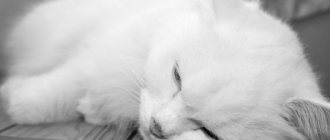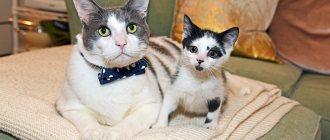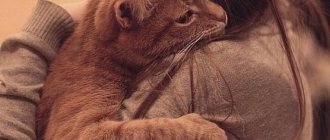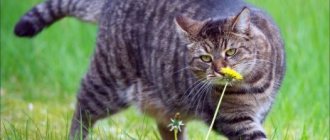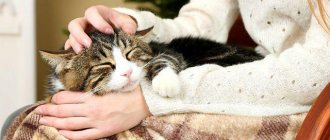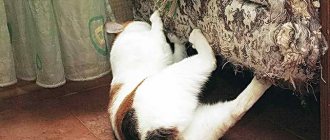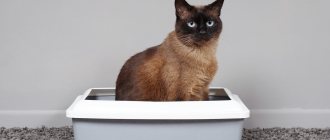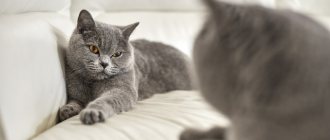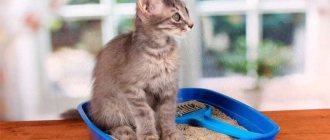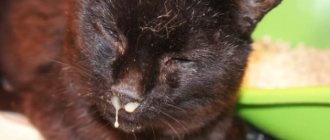A well-fed fluffy cat may seem cute. But obesity harms any living creature. Due to excess weight, purrs develop serious illnesses: diabetes, degenerative joint diseases, liver dysfunction. Fat cats live much shorter than their slender cats.
If the problem has already arisen, the owner should think about how to lose weight for a cat so that its weight becomes normal. It would seem that everything is simple: feed less. But long periods of “hungry” are harmful to representatives of the cat family. An improper diet leads to fatty liver disease, a deadly disease. Weight loss in a pet should be carried out according to the rules and under the supervision of a veterinarian.
How to lose weight for a cat?
Why does my cat need to lose weight?
A single kilogram of excess weight already increases the risk of your pet developing serious diseases. Unfortunately, if your cat is overweight or obese, it is no longer a question of whether she will develop complications and illnesses associated with it, but when exactly they will appear and how serious they will be. Most often, excess weight is accompanied by:
- Type II diabetes – it is three times more common in obese cats than in animals of normal weight;
- Heart diseases;
- Increased risk of joint injuries;
- Osteoarthrosis (arthritis);
- High pressure;
- Some forms of cancer, especially tumors in the abdominal cavity.
Overweight and obese animals tend to live shorter lives than their slender counterparts. If a cat is overweight, it moves less and becomes less energetic and playful. The purr prefers to just lie down, and because of this it is easy to miss the first signs of illness, mistaking lethargy for “normal laziness.”
Now we are just beginning to understand the danger that extra pounds can pose to both humans and their four-legged friends.
Risk factors for being overweight
Most often, excess weight occurs due to an unbalanced diet and non-compliance with feeding rules. But sometimes a cat gains extra pounds due to illness or hormonal imbalance. Therefore, an overweight pet must be shown to a veterinarian to accurately determine the cause of obesity. Based on the test results, the doctor will develop a treatment regimen or an acceptable diet.
Britons are the most likely to be overweight
There are a number of reasons that provoke extra pounds in cats:
- Regular overeating. A cat's appetite is always slightly larger than the portions required for health. If there is no control and food is always freely available, the animal will constantly overeat and gain weight.
- Low physical activity. May be associated with joint diseases or be the result of a phlegmatic temperament.
- Genetics. If the animal's ancestors were overweight, there is a high probability that the tendency to be overweight will be inherited. It can also be a feature of the breed, for example, among the British.
- Castration or sterilization. Such operations help reduce metabolism and change hormonal levels.
- Age-related changes. Older cats prefer to nap in a cozy place most of the time, and their metabolism is slower. All this leads to an increase in body weight due to fat.
Preventing excess weight for spayed or neutered pets
Often cats become fat due to genetic defects. They may be associated with problems in the ovaries, pancreas and thyroid glands.
Sometimes failures occur during pregnancy and childbirth. Typically, dysfunctions are manifested not only by the accumulation of fat on the sides, but also by hair loss or dullness, and loss of elasticity.
Young cats are rarely fat
To return your pet to its former shape, you need to force him to lose weight so that weight loss does not cause deterioration in health. The important thing to remember here is that obesity does not happen suddenly. This is a gradual process, usually starting in mature or neutered animals. Vigorous feline youth are rarely fat. Particular attention should be paid to your pet's nutritional rules in winter, when activity decreases.
Where to begin?
In theory, it's simple: consume fewer calories, burn more, and this will lead to weight loss. Unfortunately, in reality everything is somewhat more complicated. Never put your cat on a diet without consulting your veterinarian.
Physiologically, cats are different from humans and dogs, and a two-day fast can lead to the development of a fatal disease known as hepatic lipidosis (or fatty liver disease). Your cat should first be seen by a veterinarian, who may order additional tests to make sure there are no underlying medical conditions or other barriers to weight loss. If everything is fine, you can already think about how to help your cat lose weight.
Prevention
There are a few simple rules that will help prevent your beloved mustache from becoming overweight:
Along with appearance, obesity affects internal organs. A problem like this indicates that your friend’s life is shortening. Fatty masses envelop the internal organs and increase the load on the joints and heart.
Pay attention to the quality of the food you give. It’s better to spend money and live with a healthy and active cat than to feed it to obesity and disease, spending even more
Do not mix or alternate natural and dry food. Make a meal schedule and feed strictly according to it. If your cat follows you around and demands dinner at an untimely time, remain persistent and do not give in to provocations. In a week he will get used to it and won’t beg. Don't try to pay off with food. Whiskers, like all pets, require attention, and you should give it. Don’t think that giving him an extra piece of sausage will replace rubbing his tummy. Do not prohibit active games. The pet must be provided with a sufficient amount of exercise. After all, by their nature they are predators and must hunt for food. He may now be a domestic lump, but he has instincts. Watching a sunbeam, playing with a ball or restlessly running around the house is a kind of hunt. Take part in the games, it will be useful for the cat and you yourself will get a boost of positivity by watching the jumping hunter. Change the diet if your pet has undergone sterilization surgery. Such animals require a special diet.
As you can see, preventing obesity is not at all difficult. But if this happens, you must definitely find a way to help your cat lose weight. Don't start with a solution to the problem, you'll only make it worse. Be sure to go for a consultation with a doctor who will tell you how to properly and painlessly return your cat to its former shape.
Show patience, attention and care to your full-eared cat, and together you can achieve results
How to feed a cat to make it lose weight?
To answer this question, your veterinarian will need to examine your cat and, based on her body type and size, determine what weight would be ideal for her. Specially developed formulas and graphs will help him with this, thanks to which he can also calculate the cat’s calorie needs per day in order to achieve the desired weight without harm to health.
On average, an adult domestic cat should weigh 3.6 – 4.4 kg. Depending on the degree of obesity, your doctor may recommend first achieving an intermediate weight, which is slightly larger than your ideal weight. For example, if your cat weighs around 8kg, her ideal weight would be 4.4 – 5.5kg, but a more realistic target would be an intermediate weight of 6.8kg. Once it has been achieved, it is necessary to re-evaluate the pet’s condition and determine whether the cat should lose weight further.
Weight norm and obesity
The normal weight of a medium-sized cat is in the range of 3.5–5 kg. Female cats have less body weight, and the indicators decrease by about a kilogram. There are also large breeds whose optimal weight is higher - both male and female. For example, Maine Coons have this range of 7–9 kg. Also, in all animals, muscle mass produces more weight than fat. A muscular cat can weigh more than five kilos, but will not suffer from obesity. To check if there is a problem, visual tests are performed. A warning sign is that:
- the ribs cannot be felt if you stroke the cat along the sides;
- when the animal lies on its side, the belly protrudes sideways and upwards;
- when a cat stands on four legs, the belly sags;
- shortness of breath appears, breathing slows down;
- the cat becomes lazy and rests most of the time;
- the gait changes - the pet begins to waddle.
All these signs indicate that your pet should be shown to a veterinarian and an appropriate diet and physical activity should be selected.
Cats are usually smaller in size and weight than cats
How to calculate your cat's calorie needs
The weight loss formula for cats is based on the cat's resting energy requirement (the number of calories a cat needs when not physically active, or PEED), which is calculated as follows:
- Method: PEPP in kcal/day = 70 x (ideal weight in kg) x by ¾;
- Method: PEPP in kcal/day = 30 x (total weight in kilograms) + 70.
To lose weight, a cat must receive 80% of the PEPP (multiply the PEPP by 0.8). In order not to waste time on calculations, you can use the table:
| Ideal Weight: lbs (kg) | Calories that make up 80% of your daily nutritional intake |
| 8 (3,6) | 180 |
| 10 (4,5) | 210 |
| 12 (5,4) | 230 |
Please note: These are general guidelines and cannot replace the advice of your veterinarian. If your cat is unable to lose weight by consuming the specified amount of calories, it should be reduced.
Games are the best exercise
ravepad.com
The easiest way to help your cat maintain a healthy lifestyle is to play with him. Even a few minutes a day will help.
Try to interest the fat man in new toys and see how he himself demands activity from you! You don't have to spend all your savings; a homemade mouse or an inexpensive laser pointer will also work.
It's even easier to get a second cat and see how busy they are with each other. This is a great option for people who spend most of the day at work.
Which food to choose?
Since cats are obligate carnivores, human diets are not suitable for them. A diet high in protein and low in carbohydrates should help your cat lose weight. This is exactly the food you need to choose.
The amount of food needed to provide the required amount of calories depends on its calorie content. Usually the calorie content of the food is indicated on the packaging, and a specialist will explain to you what portions it should be given.
Usually, a cat loses weight most effectively by receiving dietary canned or dry food several times a day. You can’t leave it in a bowl while losing weight, because regular meals are healthier than constant snacking throughout the day. How to make a cat lose weight if it always has the opportunity to crunch on something out of boredom or for pleasure?
It is very important to learn how to count calories and measure the prescribed amount of food. If there is too much food, the animal will not lose weight, and if there is too little, it will begin to starve, which, as already mentioned, is very dangerous for cats.
Where does excess weight come from in a pet?
Losing weight is difficult for both humans and cats - especially for sterilized animals
And initially, it is very important for the pet owner to monitor the pet’s diet and control the amount of food consumed. Indeed, in addition to diseases, obesity can significantly shorten the life of an animal
A cat becomes fat if it eats more than it needs. That is, he consumes calories above the norm. During the first years of its life, a cat consumes a lot of food instinctively because it is growing and it needs it. At the same time, small cats are still very active and playful, so they are not at risk of obesity. But what if their appetite does not decrease over the years, but only grows? Add to this the decrease in activity in the adult and you get a combination like a lazy fat cat. Spayed and neutered cats are especially lazy and gluttonous, so they are more prone to obesity.
How long does it take to train a cat to go on a diet?
Give your cat a week or two to get used to the new diet. First, mix ¼ of the new food with ¾ of the usual food for 2 to 4 days. Then increase the amount of new food to half, and in the last 3 to 5 days before the final transition to the new diet - to ¾.
To improve palatability, you can heat the food and add flavoring additives, for example, based on fish oil containing Omega-3 fatty acids.
If your cat refuses a new diet, or if you have any questions while introducing her to a new food, do not hesitate to contact your veterinarian for advice.
Causes of weight problems
The most common cause of excess weight gain is an imbalance between calorie intake and calorie use.
In other words, a cat consumes more calories than it can use as energy, since the adult cat's appetite often exceeds its needs. This is also due to improper diet and feeding frequency. Note that most weight problems develop gradually and often begin in middle age, when a cat's physical activity level naturally declines and caloric intake remains unchanged. Some pets also become less active during the winter months. Spayed and neutered pets also have a lower energy requirement, which should be taken into account when planning their diet.
Many pets follow a free feeding schedule where food is available all the time and they eat whenever they want. This situation becomes the main factor contributing to feline obesity, since it is unnatural for the true predator that the cat has evolved to be. As a general rule, it is recommended that your cat be fed 2-4 small meals daily and not have continuous access to food. When choosing the serving size, focus on the size of the cat’s usual prey – a medium-sized mouse.
Controlling the weight loss process
It is recommended to change the diet gradually over 3-4 weeks, gradually reducing the percentage of the old diet and increasing the percentage of the new one.
After switching to a new diet, it is necessary to monitor your pet’s weight for several weeks. Weigh your cat weekly on the same scale at the same time of day to ensure accurate weight measurements. This will help you evaluate your progress and, if necessary, reduce or increase the amount of food depending on the result.
Remember that in the process of losing weight there may come a time when your cat’s weight plateaus at one level. This is quite common, so you should still stick to your new eating plan.
Increase physical activity
Most cats spend most of their time lying on the couch, dozing, with nothing going on to pique their interest. Therefore, in addition to changing the diet, it is important to increase your pet's physical activity level, which will help burn more calories. This is much more difficult to do for a cat than for a dog, who just needs to take him for a run or throw a ball to him.
To improve your cat's physical activity, you can play with it using various devices. For example, move the beam of a laser pointer along the floor and walls or tease her with a wand topped with feathers to awaken her hunting reflex. You can also use interactive toys that realistically imitate fleeing prey. Or try other ideas to involve your pet in the gameplay. Running wheel for cats - cat track from the studio Plotnik Peter perfectly solves the problem of physical activity for cats.
Maintaining the result
Once your cat reaches her optimal weight, adjust her calorie intake to her body size and activity level so that her body weight remains stable. Remember to exercise regularly and still weigh her periodically to make sure she is not gaining weight.
You will be surprised how much more active, agile and cheerful your feline friend will become at an optimal weight!
Obesity affects not only people, but also animals. Many people think that the large size of a cat makes it cute. It’s so nice to hug and squeeze a huge, fluffy ball, allowing you to do whatever you want in it. The number of fat animals is increasing at a rapid rate. The owners do not think about the consequences this could lead to. Excess weight in cats not only harms their appearance, but also their health. This kind of problem needs to be dealt with. Is your pet in this situation? You need to know the reasons and how to safely lose weight for your cat.
How to get your cat to move more?
In an ideal world, you could go for a morning run with her, but unfortunately, we don't live in an ideal world. Making a cat lose weight by exercising with it is not just difficult - it goes against the very nature of this animal.
Sprinters, not marathon runners
Cats are not adapted to the lifestyle of scavengers or pack hunters, like humans and dogs. They are ambush predators that expend very little energy searching for prey and rarely venture beyond their territory. Having discovered prey, the cat launches into a very intense and short chase.
Most wild cats chase prey at top speed for no more than a minute. When the chase is over, the cat requires many hours of recovery for the next hunt.
Domestic cats are smaller versions of wild cats. We can take our dog with us for a walk or jog, but among cats there are only a few who love active recreation. Cats prefer short distances rather than marathons. You will have to call on all your ingenuity to help make the mustachioed hulks move more.
Useful ideas
Place the food bowl in different places, such as at the top or bottom of the stairs, and try to place it so that the cat has to travel a certain distance before reaching the food. Cats are smart: having realized that the bowl is now at the top, they themselves will go upstairs more often.
Place the food bowl as far as possible from the cat's preferred areas. Many obese cats sleep and rest near a bowl so they don't have to walk far to get food.
Buy food container toys - they are usually shaped like a ball that the cat rolls to get the treat. You need to put a certain amount of dry food inside these interactive toys, and the cat will have to work hard to get it.
Take time to play with your cat, use feather teasers, laser pointers, paper or foil balls - anything that your cat will be interested in catching. Try playing with your cat for ten minutes twice a day. This can be done while eating, watching TV or even reading.
There are many moving and squeaking toys that may interest your cat. Cats love variety, and a toy that the animal liked today may become boring tomorrow.
Weight loss program for fat cats
It is developed by a veterinarian if the cat does not need treatment for a systemic disease. In this case, the main directions of the weight loss plan will be a gradual change in diet and increased physical activity. Usually, doctors determine the cat’s ideal weight and an intermediate weight to which he first needs to lose weight. After all, rapid loss of body weight will only harm the health of the purr.
Examination by a veterinarian
Dietary recommendations for cats
Most often, veterinarians recommend that owners of fat cats change their pet’s food or reduce portions. You need to act gradually so as not to cause stress in the animal. Doctors advise adding a quarter of the new food to the main food in the first days, then gradually increasing its ratio in the bowl.
How long it takes to accustom a cat to a diet depends on how quickly it gets used to healthy food, but on average it takes a couple of weeks.
After the cat completely switches to the new diet, it should be weighed every week to record whether there are any positive changes. If at first the weight decreased, but then the process stalled, this is normal. Continue to feed your pet according to the new scheme, and when the “plateau” is overcome, the weight will go down again. But if there are no results within a month, you need to adjust your diet together with your veterinarian.
The new food needs to be slowly mixed with the old one so that the animal gets used to it.
Feeding frequency
Sometimes, for a cat to return to its previous form, it is enough to change its diet: remove bowls of food from constant free access. Domestic cats need to be given food four times a day in small portions - the size of an average mouse.
You will have to get used to the new diet
Reducing caloric intake
Portions should be reduced gradually so that the animal does not suffer from stress. If you are wondering how to make a fat cat lose weight, you cannot keep it on a starvation diet - it will get sick. The maximum that an animal can lose is 2% of its own weight. To achieve this, the overall diet is reduced by an average of 15% or food with a reduced calorie content is chosen. In the latter case, you can focus on average indicators for how much you need to reduce caloric intake if the cat moves very little.
Low-calorie food for adult cats
The volume of breakfast, lunch and dinner is gradually reduced
Table 1. Daily kilocalorie intake to achieve the cat's ideal weight.
| Required body weight, kg | Calorie content of food per day, Kcal |
| 3,5 | 180 |
| 4,5 | 210 |
| 5,5 | 230 |
For larger cats, the average caloric intake of a diet that will lead to weight loss can be calculated using the formula: 80%x(70x(required weight)x¾). This calculation is an average; figures may vary depending on the breed.
Correct menu
Natural food for small cats is birds and mice. That is, almost completely protein. And dry food usually contains a lot of carbohydrates from grains. This contributes to weight gain and the development of diabetes. In order for a cat to lose weight, it needs to be fed either a ready-made high-protein, expensive formula, or an analogue of natural food.
In an optimal cat menu, proteins, fats and carbohydrates should be approximately in the following proportion: 5:3:2.
But when switching to a diet close to natural, you cannot give the cat only meat. But it must be there. Preferably low-fat varieties: turkey, chicken, rabbit. Additionally, the diet includes:
- low-fat boiled fish;
- cereals without steam treatment;
- low-fat dairy products.
Be sure to supplement your diet with vitamins as recommended by your veterinarian. You should not salt your cat's food. Your pet should have fresh water available at all times.
Protein foods are the basis of the diet
Healthy “snacks”
If you want to please your pet and reward him for good behavior, you should not treat him with store-bought treats or sausage. Such products contain additives and flavorings that are not very healthy and increase appetite. And some store-bought “snacks” are even addictive. It is better to treat your pet with a slice of boiled chicken or fish without spices.
Cats should not eat human food, especially if they are losing weight.
Increase physical activity
Cats are predatory animals, but they hunt from ambush and are not inclined to travel long distances to chase or track prey. And at home, when there is no need to hunt, they become completely lazy. They spend most of the day in blissful bliss and gain extra pounds.
Important! Physical activity is extremely important for effective weight loss - it speeds up calorie burning and metabolism.
Cat "fitness"
It is incredibly difficult to distract a fat cat from his nap. But underneath the layer of fat lies a wild and brave hunter. You just need to remind your pet about this. The main way to get your cat to move more is to play with it. Various devices help with this:
- laser pointers;
- interactive mice;
- various balls;
- squeaker toys.
Even a piece of paper on a string or a simple ball can interest a cat. But you will have to constantly come up with something new - cats do not tolerate monotony, and one single ball will quickly get boring.
Kids are the best “trainers” of fat cats
The best “fitness trainer” for a cat is a preschooler. The baby will be happy to bother the sloth and come up with a variety of fun games.
Additional loads
There are a few more tricks on how to make an overweight cat lose weight:
- Placing a bowl of food away from its usual place so that the cat still has to take a walk “to hunt.” In this case, the bowl must be removed after eating, and at the next meal, moved to a neighboring place a little further away. Otherwise, the fat man will settle down to rest next to the feeding area.
- Buying an unusual feeder so that the sloth has to sweat before getting food. But it should not be an automatic feeder in which food is always available.
- Purchasing toys that you can put dry food inside. It is also quite difficult to get.
Don't let your sloth relax near your bowl
You can come up with any tricks to make a fat cat move and lose weight. There are even special animal gyms where cats lose weight under the guidance of trainers. If there is one nearby and you have the means, why not buy your pet a subscription.
How often should you re-weigh?
Once you have developed a plan for how to lose weight for a cat in such and such a time, with your help, it is very important to understand whether it is effective.
Each cat is unique, and the recommended diet may require several adjustments before you see results. On average, a cat should be weighed every month until it reaches its ideal weight. If there is no result within a month (weight loss of about half a kilo), the program needs to be adjusted. Sometimes even a small change is enough.
Feeding Obese Cats Natural Products
If your animal has gained excess weight on a natural diet, you should also reconsider its diet. Don't forget that a healthy adult cat's diet should include proteins and fats of animal origin. You shouldn’t suddenly switch your furry pet to plant foods or greatly reduce portion sizes: this will only provoke unnecessary stress. Veterinarians recommend using the following products to feed overweight cats:
- Meat, offal and fish contain the required amount of protein and essential amino acids. Lean beef, rabbit, chicken or turkey are suitable for dietary nutrition. Of the by-products, preference should be given to hearts and liver. Meat should be served boiled or fresh frozen to destroy helminths. For dietary nutrition, steamed sea fish (trout, salmon) is mainly used.
- Milk based products. Kefir, cottage cheese, fermented baked milk, goat cheese, bifidok are sources of calcium and easily digestible protein, so they must be included in the cat’s diet. Please note that their fat content should not exceed 2–5%.
- Porridge and cereals. The fiber they contain provides satiety and acts as a natural scrub for the intestines, removing toxins. Cereals that are healthy for cats include rolled oats, brown rice, and millet. They need to be boiled in water or chicken broth.
- Greens and vegetables. They are used as an additive to cereals or meat: they should be boiled and ground in a blender. The best foods for feeding cats are spinach, celery, zucchini, squash, green beans, carrots, broccoli, and cauliflower.
Photo gallery: healthy foods for pets
By-products contain the required amount of protein
Dairy products are rich in calcium
Vegetables are the best source of vitamins and minerals
It is harmful to feed cats from the home table: our food contains a large amount of salt and various additives that negatively affect their health. Such a diet contributes to the development of obesity and other dangerous diseases. Veterinarians strictly prohibit giving overweight cats the following foods:
- sausage, frankfurters, small sausages;
- semi-finished products (cutlets, zrazy, dumplings);
- butter;
- chicken skin and fat from meat;
- bones;
- processed cheese;
- ice cream;
- sweet yoghurts and curds.
What to do if your cat is constantly begging for food?
When cats wake us up at four in the morning, demanding food, screaming like crazy, or non-stop poking their foreheads at their owner, we give up. The cats have trained us well, they know very well which buttons to press to get what they want! Here are some tips for pacifying annoying Persians or irrepressible Siamese:
- Do not use automatic feeders. It is quite obvious that the automatic feeder for the fat tailed man is a machine filled to the brim with candies.
- Pet your cat or play with her when she begs for food. Many cats perceive food as equivalent to their owner's attention, and you may find over time that play replaces the cat's meal.
- Feed your animal in smaller portions, but more often, so you can provide a late dinner for a cat who likes to wake you up in the morning. Divide your total calories into four to six small portions. The most important thing is not to give your cat food in excess of the prescribed amount.
- If the bowl is empty and the cat won't calm down, put a couple of pieces of food in the bowl. A couple of pieces, not a handful.
- Offer your cat fresh water instead of food. When your cat is persistently staring at an empty bowl, a sip of fresh, cold water can curb her appetite.
Increasing physical activity
It is very important for obese cats to increase physical activity
The fat one must move.
Movement is necessary for losing weight. She does not need to suffer either on the treadmill or in cat aerobics classes.
The best gymnastics for Murka is her favorite sport - hunting. So you should awaken the hunter's instincts in the cat.
To do this, you will need a piece of paper folded like an accordion on a string, which can be held either directly in your hand or on a stick “fishing rod” for cats. These animals love to chase such a toy, powered by the owner's hand.
If the animal does not want to chase such a toy, you can take it to the country or simply release it into the yard, where the animal will run and lose fat.
There is also another way: you can put one or two toys in each room, filling them with pieces of dry food taken from the bowl. Let your pet work to get some food. At the same time he will have fun.
Well, the third method: put the bowl in a different place each time (you can repeat it, but don’t put it twice in a row in the same place), and so that the animal has to work with its paws to get to the food.
You can place a bowl of food in different places to encourage your cat to be active.
These animals have good brains. If the cat understands that its “dining room” is on top, it will often go up there and then wait there for the next portion.
If she likes a certain place, place the bowl of food away from there. Many fat cats prefer to rest close to the bowl because they do not like to travel long distances for food.
Cats like variety. That’s why it’s best to change toys and entertainment so that you don’t get tired of them.
How to feed other cats if only one needs to lose weight?
You may find a better solution to the problem, but here are some tips to get you started:
- Feeding cats separately is the ideal solution for such cases. Give your losing cat some diet food in one room and feed the rest in another. When the time allotted for a meal is over - usually from fifteen minutes to half an hour - remove what the animals did not eat until the next feeding.
- Feed a cat that is not overweight at the top, where it is more difficult for an overweight cat to climb.
- Never leave food out in the open unattended. This way you won’t be able to control who eats what and when!
Features of cat weight loss
Owners of well-fed animals have many questions about the intricacies of weight loss in cats. Here are the answers to the most common ones:
- How often and for how long does it take to play with a fat cat? Doctors recommend at least 30 minutes daily.
You need to play with your cat for half an hour a day or more.
- How long does a cat diet last? It depends on how overweight the animal is, the age and temperament of the animal. On average, fat cats reach their ideal shape within six months of diet and increased physical activity. But in order to maintain a normal weight, you will have to adhere to dietary restrictions throughout your life.
- How much can a cat lose per month? Healthy weight loss does not involve losing more than half a pound in 30 days. But even smaller results are good, the main thing is that there is progress. If it is not there, the weight loss plan needs to be adjusted.
- How to feed if there are several cats, but only one is overweight? Ideally, it is better to install bowls for them in different rooms. And remove them so that the fat woman does not penetrate into someone else’s territory and eat up her “colleagues.” The second option is to place the bowls higher for skinny people. Well-fed cats find it difficult to climb onto high ground. But you need to carefully monitor the process of eating: gourmets are capable of much for the sake of delicacy.
- What should you do if your animal is always begging for food? You need to have nerves of steel to resist touching glances or endless screams. But you have to do this for the sake of your pet’s health. To calm an animal, you need to caress it, stroke it, and distract it. Another way is to feed your pet small portions, but often. This way he won't have time to get hungry. As a last resort, you can give an extra couple of pieces of food, but no more.
The touching glances of beggars will have to be ignored
An important point is the peculiarities of weight loss (weight loss) of sterilized cats and neutered cats. They will definitely have to change food, choosing a specialized one. And their bowls must always be filled with clean drinking water. This needs to be monitored especially carefully, because such food severely dehydrates the body. It is better to give filtered water. Salts contained in untreated water provoke the formation of stones in the urinary ducts.
How long will my cat have to be on the diet?
Most cats reach their ideal weight within 6 to 8 months. If the process is delayed, then something needs to be changed. Healthy weight loss is about a pound per month. Some cats take longer, while others lose weight faster.
For most cats, the secret to effective weight loss is attentive and responsible owners. Cats don't understand that obesity is killing them. We, as good owners, must protect them from danger and, of course, not unwittingly contribute to their development of serious illnesses or their premature death.
Only by working closely with your veterinarian and your entire family can you ensure that your cat remains fit and healthy.
The recommendations are based on the work of veterinarian Ernest Ward.
What diet should I put my cat on if his weight exceeds the norm?
On the one hand, if the cat does not go outside, and the refrigerator is tightly closed, the question “how to lose weight for a cat” can be solved very simply: give less food
. A cat, unlike a human, will not go off the diet, and he will not be in danger of raiding the contents of the refrigerator.
On the other hand, a malnourished hungry cat can so fray the nerves of everyone in the family that everyone will become sorry and start feeding the cat three times as much!
Therefore, the correct solution to the problem of “how to lose weight for a cat” is not to reduce the portions, but to change their composition
.
If the cat is “artificial” - that is, eats ready-made food - consult a veterinarian so that he can recommend a special medicinal food for obesity
. Portions of “drying” should be gradually reduced, divided into a larger number of feedings, so that the cat does not feel hungry.
Sometimes there is advice to switch your cat to natural food.
The veterinarian will also determine what is causing the obesity and whether additional treatment is required.
– since this is not always a consequence of simple overeating, the risk of hormonal changes in the animal’s body cannot be excluded.
If you feed your cat exclusively natural food, then make sure that there is more fiber
– boiled vegetables, cereals. Eliminate fatty meats and replace them with lean fish and chicken.
And very important - no bounty from the human table
!
No “one ring of sausage so you don’t meow”, no sprats, herring heads, etc.! Also, make sure that the trash can is taken out in a timely manner - cats, when on a diet, lose all notions of nobility and are not averse to being homeless in the trash...
